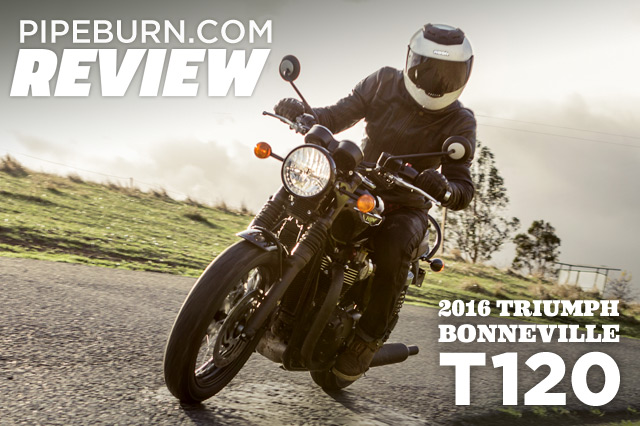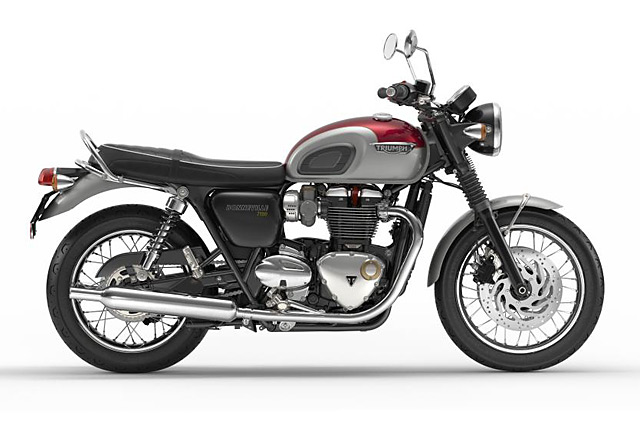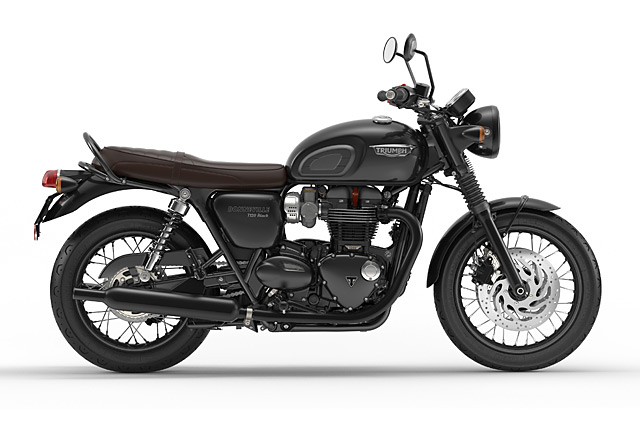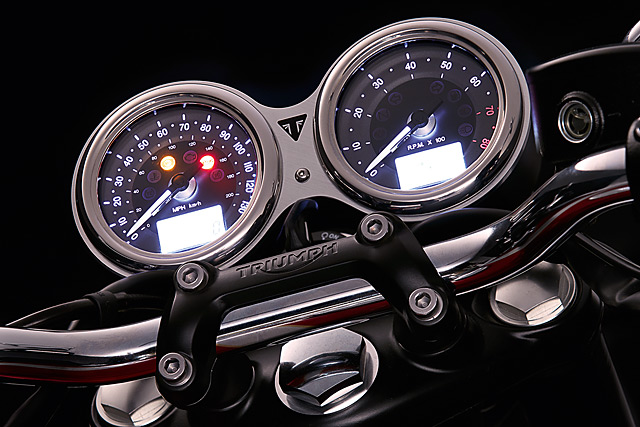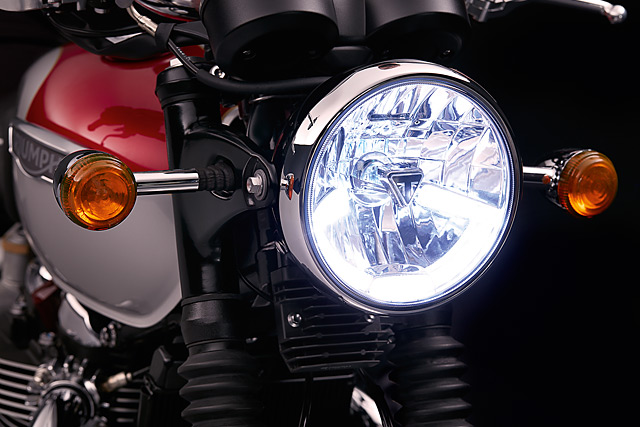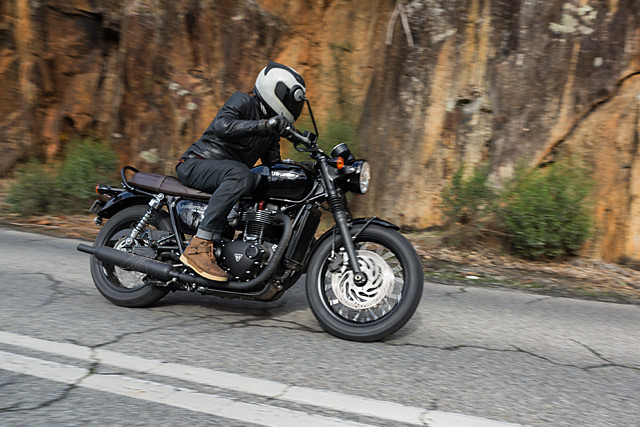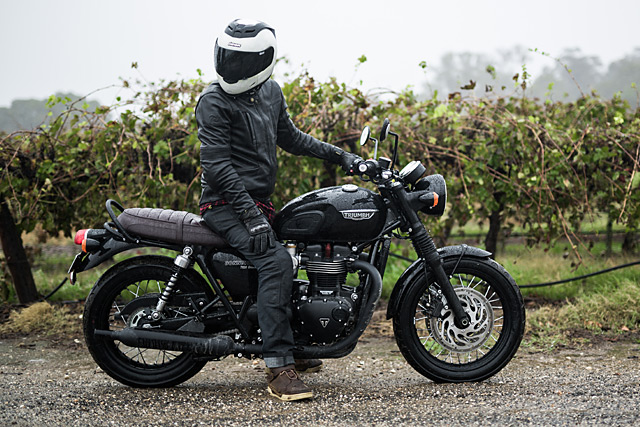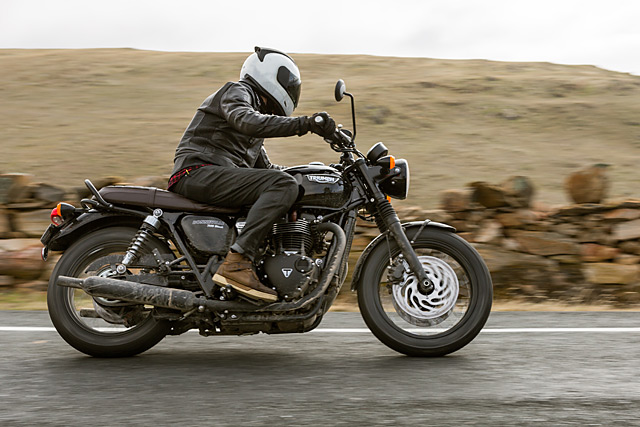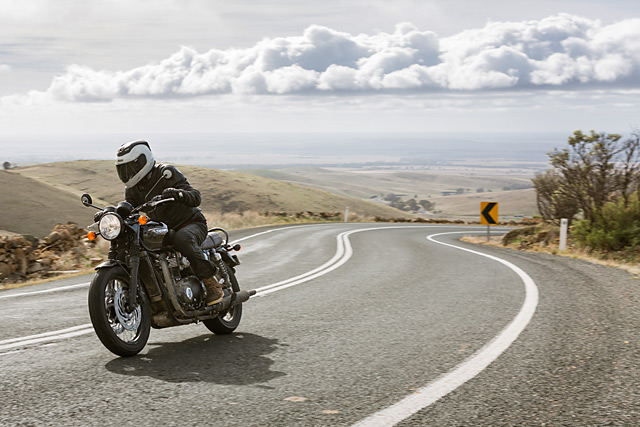The challenge Triumph gave themselves when redesigning the Bonneville was nothing short of Herculean. As a company whose entire brand rests on one hundred plus years of biking heritage, this is the bike around which their entire world revolves. How hollow would their references to legendary motorcycling heroes such as Steve McQueen and Marlon Brando sound if the new Bonneville missed the mark? So to this end, the brief from John Bloor, Triumph’s owner, was as clear as it was short. It had to be as good as the original ‘59 Bonneville T120, “and whatever you do,” he said “do not fuck it up.” Which begs the question, did they or didn’t they? To find out, Triumph Australia asked us to take the bikes on an epic journey over some of the most challenging landscapes in Australia to do battle with the weather and the road in a ride we’ll be telling our grandchildren about for years to come.
The path for our adventure had been mapped and strategised by Triumph, almost as if to recreate the trouble and effort they went through to build the damn thing. We would push north-east from Adelaide, South Australia’s capital and gateway to the fertile Barossa Valley wine country beyond. Long inhabited by Germans immigrants who fled their motherland hundreds of years ago, it’s also well-known for its microclimate. This is what helps the grapes grow and makes the soil the best of its kind this side of the Pyrenees. And while the thought of fine wines no doubt put a broad smile on the faces of the assembled press corps, there was one inescapable downside. It was raining and cold as hell.
First Impressions
The T120 is an impressive bike at first sight. With acres more chrome and very little plastic bolstering the ranks, it feels like a more capable, more impressive bike than before, even before you saddle up. While only marginally longer and heavier than the Street Twin, it also feels like a whole lot more bike than its kid brother. Once seated, the quality and thought that’s been put into the build becomes even more apparent. From the ignition key and fuel tank right through to the crank cases and spoked wheels, it’s clear that someone at Triumph has put some major effort into this bike. And while the beautifully festooned, 14.5 lt. (3.8 gal) tank’s shape seems substantial in profile, its rearward-tapering profile means legs are alway comfy.
The crowning achievement of all this spit and polish is the instrument cluster. While the dual dials stubbornly refuse to remember the display settings you chose during the previous ride, they do immediately feel ‘right’ for the bike. The choice of metals, workmanship, and back lighting are all made with the understanding that it’s here the future owners will be looking most closely while riding. So if you want to impress them, what better place to do it than right here? This attention to detail flows through to the rest of the bike, too. Once your eyes be accustomed to the bikes appearance, it’s clear that the engine is a beautiful thing to behold and the way it’s topped of by the tank – especially in the Cranberry Red and Aluminium Silver – is something you would never tire of. It’s clearly a beautiful-looking engine.
Other train-spotting engine details include a 54% increase in torque over the old model with a vast majority of it making an appearance before 4000 rpm. Like just about every other manufacturer out there, the bike now has a 270˚ degree crank. I’m not complaining though, as it sounds great and delivers its argy-bargy beautifully through a six speed ‘box. Amazingly, the new 1200cc power plant is no bigger than the old 865cc unit, and it’s water-cooled. A side-by-side comparo of the old and new models also proves that new bike is a much cleaner proposition overall, with less tabs, cabling and other visual detritus messing up the silhouette.
The non-engine improvements are headed up by the suspension. It’s no secret – even amongst Triumph’s own ranks – that the suspension on the old model was nothing to write home about. And while the new set-up isn’t groundbreaking, it tracks well and never feels uncertain, even when pushed hard. There’s also adjustable traction control, ABS, a slipper clutch, LED lights and heated grips. It’s probably a very ‘Aussie’ thing to admit, but I’d never experienced heated grips before. After this ride I’m a big fan. They’re the best thing since sliced, toasted bread.
Then there’s the bike’s Amal ‘carburettors’. Of course they can’t be Amals. Thanks for nothing, Euro 4. So they must be throttle bodies, then. I think I understand what Triumph’s designers intended with this design, but I can’t escape the nagging thought that this is function following form par excellence. Be it 1959, the present day or 218 BC, I’m pretty sure that the shape of something should be dictated by its intended use. One thing pretending to be another seems rather pointless to me. Nit picky? Maybe. Let me know your thoughts in the comments below.
The Rain
Gearing up with as much warm gear as we could beg, borrow or steal, we set off into the rain. Hannibal-like neoprene face masks protected some of the riders that had chosen open-faced helmets. Thank the gods I didn’t. North-east we headed, to the Adelaide Hills. The initial on-road impressions of the bike are excellent. Indeed, it seems that the bike is hardly trying, which always seems to impart a certain level of comfort and confidence to the rider. The rev limiter collisions that were experienced with the Street Twin are now gone. Even with the insanity that is soon to follow, I can’t recall one single instance of me besting the beast. We then arrive at Chain of Ponds, a well-known biking hotspot that’s dissected by the aptly-named Gorge Road.
As the first photos of the day commence, we tear up and down the same stretch of road and slice through the same corner again and again until the ‘photogs’ have taken their fill of pixels. While a little tedious, it does prove a few things. The bike sounds better from behind than in the rider’s seat. This is no doubt the work of the peashooters, um, peashooting the engine’s roar reward and away from the rider’s ears. It’s still a nice sound though, especially bouncing off the sandstone walls of Gorge Road. Cornering confidence is also confirmed on these briefly dry roads. Of course, most of us would never come close to really pushing the set-up to its limits, suffice to say that it’s more than capable. And finally, the bike easily handles low-speed u-turns without throttle snatch or any other complaints. Thanks torque.
The next waypoint on Triumph’s ‘trial by weather’ was the amazing ‘Bill’s Bits & Bikes’ in Birdwood. Owned and run by Bill and Mark Mitchell, the shop is part old bike sales, part spares, part museum and all shrine to the religion of the motorcycle. Set in a small country town, the shop looks as if it hasn’t been renovated since before the birth of Christ. Tardis-like in its never-ending series of shelved nooks and crannies, it smelt of petrol, old oil and cold metal like all good bike shops should. And of course there were more old cycles than there are days in an American presidential campaign. I counted over fifty bona-fide classics in a space not much bigger than a small family home. If you can imagine what it would be like to have a vintage motorcycle infestation in your house, then this would be it. We got about 30 minutes to look around; I’m guessing you could spend ten years in there and still be finding things you’d never seen before. Ultimate man cave? Without a shadow of a doubt.
The Ascent
And as if that wasn’t enough, we were then taken to a ‘surprise’ location, the Collingrove Hillclimb Track in Angaston. Built in 1950, it’s a scant 750 metres (half a mile) long and climbs around 70 metres (or 250 feet) from start to finish. But with nothing more that a small carpark, a demountable office and a narrow strip of asphalt that disappears over the nearest hill, it was a little underwhelming at first. ‘Please don’t die,’ pronounced Triumph guy Nigel. Huh?
Bemused and confused, we were ushered off one by one over the hill. In the blink of an eye, the bikes that had just left returned from behind us. Wild exclamations emerged from their helmet-covered mouths like there was some mythical creature hiding over the hill. Naively, I clicked the ‘box into first and went off to see what all the fuss was about.
As I write this, I’m struggling to describe what happen next, so here’s the best I can do. Imagine a golden ribbon falling from the heavens onto a set of steep hills. As it touches down, it turns to bitumen. Then you ride it. I giggle, whoop, scream and swear loudly. The first right hander was immediately nicknamed ‘The Wall’. That’s it below. Going into corners way too fast and then standing on the back brakes didn’t faze the T120. Neither did the wet and badly repaired track, or the speeds at which this was all happening. How a bike or four wasn’t scuppered is beyond me. In fact, the sum total damage from Collingrove was a razed clutch from a burnout or ten. It’s repaired on the spot, and off we go into the rapidly approaching night.
Our quota for death-defying feats spent for the day, we retire to the local inn. We proceed to eat and drink like Dionysus and Bacchus themselves. While the weather regrouped outside, we sampled the finest wine and food the region had to offer, again and again and again. For a brief moment, we revelled in the fact that we weren’t hanging off the side of a asphalt-lined cliff or riding through a tempest. We laughed, we swore and we embarrassed ourselves like soldiers on their last night before battle. And the next day, without a word of exaggeration, we went to war.
The Fog and Wind
Barely eight hours later, and I can’t see anymore. Or more correctly, all I can see is white. Whiteout white. Climbing up and over the mountains that ring the valley, the rain turns to mist which then tuns to fog. I’m certain I’ve never ridden in worse conditions than these, and I’m hung over to boot. The rider in front disappears in and out of the cloudy mass like some ancestral apparition. I’m torn between speeding up so I can see him more clearly and slowing down so I don’t, you know, die. What the hell am I doing here? This is next level crazy. Triumph is crazy. The bike, as before, ignores my whining and battles on unperturbed.
“What the hell am I doing here? This is next level crazy. Triumph is crazy.”
Then, as quickly as it had appeared, the fog was gone. But our relief was soon quashed by the wind that had replaced it. Stopping at the highest point on the Stott Highway, I can only describe the landscape as mythical. Windswept and barren, it’s crisscrossed with convict-built stone walls that make it look more like European Alps than the Australia. Looking west to the pains and what hopefully would be a respite from the elements, we saw blue sky. Time for some more photos, too. The wind bullies us as we stand around waiting for the lensmen to take their places. Images of men flying like Icarus in winged suits down alpine valleys fill our heads. We stand on the rock walls and see if the wind will lift us up and carry us away to better weather.
The Stampede
The conditions start to take their toll on my senses. Time blurs and suddenly, after many hours, we are in a desert. The wind has gone and the road is now spear straight. It’s here that the T120 shows us it could actually tour quite well. We can’t vouch for pillions and luggage capacity, but the overdriven sixth gear allows for a relaxed two-and-a-half-thousand revs at around 110 km/h (70 mph) while the torque at the same point is always willing. Comfort is never an issue and even after all this, there are zero aches and pains.
It’s now, after battling the weather and apparently coming out the other side unscathed, that spirits boil over. The surrounding land is a barren void, so we fill it with speed and sound. In unison, the group’s throttles are opened wide, unleashing an almighty, pachydermal roar that emanates rearward, shot out by the peashooters we have all been armed with.
Across the dry plains we charge. The landscape refuses to lay down before us and instead rolls like long, slow waves as we move with much haste towards the next crest on the horizon. We are cutting through the desert air at a rate of knots that doesn’t bear repeating for fear of brutal retribution from the local lawmakers. Triumph’s engineers will tell you that flat-out, the T120 will reach the top of sixth gear just shy of 200 km/h (120 mph) and stay there for as many wide-eyed minutes as you dare. Especially on long, straight desert roads. Not that we tried it, of course. That kind of riding is the stuff of legends, and not for mere mortals like us.
“We are now cutting through the desert air at a rate of knots that doesn’t bear repeating”
The Gauntlet
We thought we were home free. We gloated as we sat and ate lunch at the Swan Reach Hotel. We were champions. We’d been put to the ultimate riding test and clearly we’d beaten it. All that was left to do was to ride south-west, back to Adelaide and civilisation. In our heads, we were already at another pub in the city toasting our achievements and crafting the stories we would tell. But the land and the elements had one more test for us and the bikes. One that would make everything before seem like a summer stroll through a Tuscan wheat field.
The Adelaide Hills is a natural fortification that walls off the city from the plains to its west. And with the ocean to the city’s west, here too you will often experience bad weather. Weather that drenches the slopes, and sweeps debris across the sharp, downhill roads. Debris like leaves, rocks, bark, clay, soil, and branches.
Physically shattered by my efforts to date, this was the final straw. After a few rear wheels wiggles, my confidence bid a hasty retreat and left me with nothing but a set of weak, shaking arms and exasperated cries. Hairpin after wet, slippery hairpin came at me without even so much as a moment’s break. I won’t lie to you. I was moments away from giving up. It was all too much. ‘Stop here and rest for an hour or two,’ I heard my inner voice pronounce in increasing frantic outbursts. ‘Triumph have heaps of cash – they can just send a van to pick you up.’ ‘That pub looks warm! And look; it has an open fireplace!’
“I won’t lie to you. I was moments away from giving up. It was all too much.”
Becoming delirious, time and my sanity withers away. The next thing I know, we are in that city pub. We are in front of that open fireplace. There are beers and laughing and excited recountings of what had just happened. I had made it through unscathed. Don’t ask me how, because I’m not really sure. I turned and hugged Ben, our photographer, who had stuck with me through the gauntlet. I hugged him like only a man who had gazed a slippery bitumen-covered Death square in the sockets and survived could. We had won, goddamn it. We had won.
Conclusions
I shudder to think how this ride could have gone had the stars not aligned in the way that they did. With the wrong bike, the wrong riders or some bad planning, the whole undertaking could have ended in tears. But it didn’t. I look back on the experience as some kind of dream sequence that I’m equal parts amazed by and terrified of. A story of legendary feats for the grandkids, no doubt. Whatever the details of the ride itself, Triumph knows enough about their bikes, and the T120 in particular, to realise that you’d never put ordinary bikes through an extraordinary test like this. To summon the courage to plan and execute it speaks volumes about their confidence in the bike and what it’s capable of.
To do what we did and come out the other side high-fiving each other says a lot about the bike’s design. In fact, writing this piece and trying to be level-headed about the T120 is as challenging as the ride itself. The bike never missed a beat, despite being constantly confronted with challenges. I now think of it as some kind of soulmate; despite me repeatedly losing my nerve, the T120 gently reassured me and helped me through. I almost feel as if fate paired us up to show me what I’m capable of when I really put my mind, and a great bike, to the test.
While the Triumph’s Street Twin also impressed us, the T120 plays the capable, experienced, rather more serious big brother to the Street Twin’s fun, fashionable younger sibling status. If you are looking for a high quality, capable, well-proportioned, multipurpose bike with classic looks and engine that only the very best riders would find lacking, you’d be a fool not to consider this bike for your next purchase. It’s that good. Triumph triumphs again.
– Quality build with great attention to detail
– Superb, capable engine
– Surprisingly multitalented
– Beautifully easy to ride
– Not sure about the pretend carbs
– Instrument display resets itself on start-up
[Photos by Triumph and Ben Galli. Helmet from Icon. Jacket from Pagnol. Pants from Draggin. Boots from Icon]
via PIPEBURN

